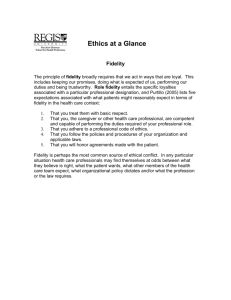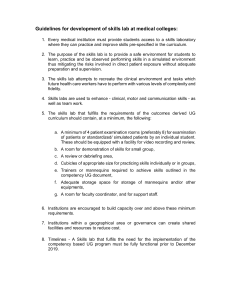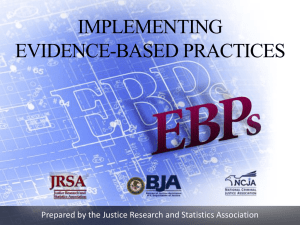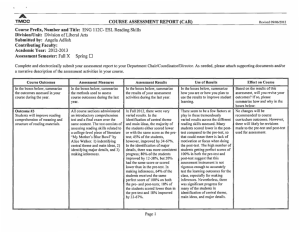Conducting Implementation Studies
advertisement
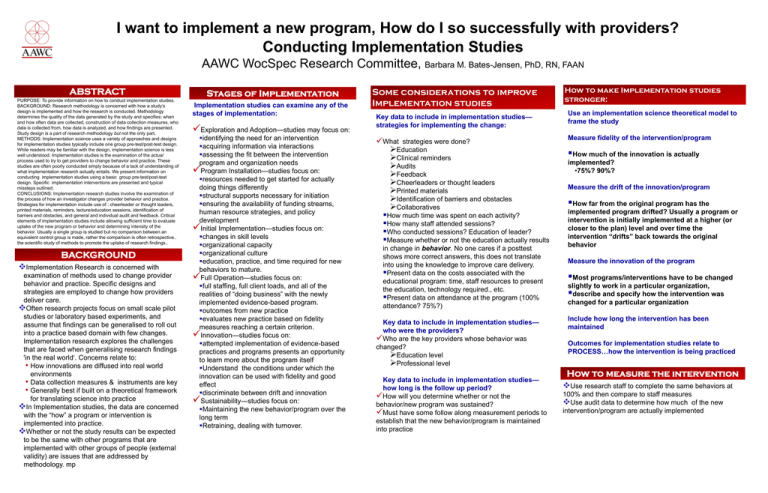
I want to implement a new program, How do I so successfully with providers? Conducting Implementation Studies AAWC WocSpec Research Committee, Barbara M. Bates-Jensen, PhD, RN, FAAN ABSTRACT PURPOSE: To provide information on how to conduct implementation studies. BACKGROUND: Research methodology is concerned with how a study’s design is implemented and how the research is conducted. Methodology determines the quality of the data generated by the study and specifies: when and how often data are collected, construction of data collection measures, who data is collected from, how data is analyzed, and how findings are presented. Study design is a part of research methodology but not the only part. METHODS: Implementation science uses a variety of approaches and designs for implementation studies typically include one group pre-test/post-test design. While readers may be familiar with the design, implementation science is less well understood. Implementation studies is the examination of the actual process used to try to get providers to change behavior and practice. These studies are often poorly conducted simply because of a lack of understanding of what implementation research actually entails. We present information on conducting implementation studies using a basic group pre-test/post-test design. Specific implementation interventions are presented and typical missteps outlined. CONCLUSIONS: Implementation research studies involve the examination of the process of how an investigator changes provider behavior and practice. Strategies for implementation include use of : cheerleader or thought leaders, printed materials, reminders, lecture/education sessions, identification of barriers and obstacles, and general and individual audit and feedback. Critical elements of implementation studies include allowing sufficient time to evaluate uptake of the new program or behavior and determining intensity of the behavior. Usually a single group is studied but no comparison between an equivalent control group is made, rather the comparison is often retrospective.. the scientific study of methods to promote the uptake of research findings.. BACKGROUND Implementation Research is concerned with examination of methods used to change provider behavior and practice. Specific designs and strategies are employed to change how providers deliver care. Often research projects focus on small scale pilot studies or laboratory based experiments, and assume that findings can be generalised to roll out into a practice based domain with few changes. Implementation research explores the challenges that are faced when generalising research findings 'in the real world‘. Concerns relate to: • How innovations are diffused into real world environments • Data collection measures & instruments are key • Generally best if built on a theoretical framework for translating science into practice In Implementation studies, the data are concerned with the “how” a program or intervention is implemented into practice. Whether or not the study results can be expected to be the same with other programs that are implemented with other groups of people (external validity) are issues that are addressed by methodology. mp Stages of Implementation Implementation studies can examine any of the stages of implementation: Exploration and Adoption—studies may focus on: identifying the need for an intervention acquiring information via interactions assessing the fit between the intervention program and organization needs Program Installation—studies focus on: resources needed to get started for actually doing things differently structural supports necessary for initiation ensuring the availability of funding streams, human resource strategies, and policy development Initial Implementation—studies focus on: changes in skill levels organizational capacity organizational culture education, practice, and time required for new behaviors to mature. Full Operation—studies focus on: full staffing, full client loads, and all of the realities of “doing business” with the newly implemented evidence-based program. outcomes from new practice evaluates new practice based on fidelity measures reaching a certain criterion. Innovation—studies focus on: attempted implementation of evidence-based practices and programs presents an opportunity to learn more about the program itself Understand the conditions under which the innovation can be used with fidelity and good effect discriminate between drift and innovation Sustainability—studies focus on: Maintaining the new behavior/program over the long term Retraining, dealing with turnover. Some considerations to improve Implementation studies Key data to include in implementation studies— strategies for implementing the change: What strategies were done? Education Clinical reminders Audits Feedback Cheerleaders or thought leaders Printed materials Identification of barriers and obstacles Collaboratives How much time was spent on each activity? How many staff attended sessions? Who conducted sessions? Education of leader? Measure whether or not the education actually results in change in behavior. No one cares if a posttest shows more correct answers, this does not translate into using the knowledge to improve care delivery. Present data on the costs associated with the educational program: time, staff resources to present the education, technology required., etc. Present data on attendance at the program (100% attendance? 75%?) Key data to include in implementation studies— who were the providers? Who are the key providers whose behavior was changed? Education level Professional level How to make Implementation studies stronger: Use an implementation science theoretical model to frame the study Measure fidelity of the intervention/program How much of the innovation is actually implemented? •75%? 90%? Measure the drift of the innovation/program How far from the original program has the implemented program drifted? Usually a program or intervention is initially implemented at a higher (or closer to the plan) level and over time the intervention “drifts” back towards the original behavior Measure the innovation of the program Most programs/interventions have to be changed slightly to work in a particular organization, describe and specify how the intervention was changed for a particular organization Include how long the intervention has been maintained Outcomes for implementation studies relate to PROCESS…how the intervention is being practiced How to measure the intervention Key data to include in implementation studies— how long is the follow up period? How will you determine whether or not the behavior/new program was sustained? Must have some follow along measurement periods to establish that the new behavior/program is maintained into practice Use research staff to complete the same behaviors at 100% and then compare to staff measures Use audit data to determine how much of the new intervention/program are actually implemented
